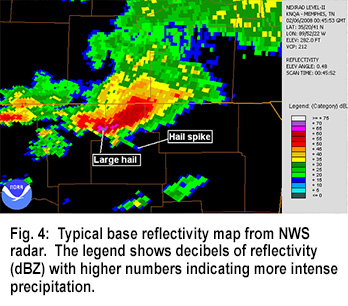What can radar tell us about hail?
By Tim Marshall, P.E., Meteorologist, Haag Principal Engineer
| Have you ever wondered whether National Weather Service (NWS) radars can tell if it hailed on a particular roof? There is a high probability it can! Radar information is available online from the National Climatic Data Center at: https://www.ncdc.noaa.gov/data-access/radar-data as well as other sources. Haag engineers and meteorologists routinely study radar images or analyses to determine the likelihood that hail fell at a specific location. Such information can help our clients better understand hail history. Radar studies have shown good correlation in determining hail aloft and whether it reaches the ground. However, there are too many uncertainties with weather radar to accurately tell maximum hail size at a particular location. While some organizations provide such algorithm output, this type of data must be reviewed with caution and correlated with all other available evidence. Haag engineers and meteorologists conduct site specific inspections to verify if it hailed and determine the size, hardness, and direction of hail fall. We look for the presence of scuff marks on wood surfaces and spatter marks on metal and other surfaces that have oxidation, grime, and organic growths. Such marks are usually visible within a year or two after the hail event. Radar output does not take the place of detailed site specific inspections.
The following is a short treatise on radar to better explain what it can and cannot do. Radar is an acronym that stands for Radio Detection and Ranging. It was developed during WWII to track aircraft and missiles. Advancements in technology have greatly improved radar quality and resolution over the years. Today, there are more than 150 weather radars operated by the National Weather Service throughout the U.S. These radars emit extremely short bursts of radio waves, called pulses. Each pulse of energy lasts about 0.00000157 seconds (1.57×10-6), with a 0.00099843-second (998.43×10-6) “listening period” in between. The transmitted radio waves move through the atmosphere at about the speed of light. By knowing the direction the antenna is pointed, and timing of returned energy, the location of the target can be determined. Generally, the better the target is at reflecting radio waves (i.e., more raindrops, larger hailstones, etc.), the stronger the reflected radio waves, or echo, will be. This is because the energy reflected is proportional to the target diameters to the sixth power. The radar antenna is 28 feet wide and contained within a fiberglass radome to protect it from the weather. The antenna is mounted on a tower to limit interference of near ground obstructions (Figure 2). Every five minutes or so, the radar conducts a volume scan, rotating up to 19.5 degrees above the horizon, and providing a “snapshot” of echo intensity and location. Radar cannot see above 19.5 degrees which might not even see a storm very close to the radar site. The area not sampled above the radar is called the “cone of silence” (Figure 3). Also, radar does not sample below 0.5 degrees to minimize ground interference and radiating people. The radar antenna samples the returned energy at some height above the ground. Also, radar resolution decreases with increasing distance as the radar beam widens and rises above the ground; the latter occurs due to the curvature of the earth. Just because radar might detect hail aloft, does not necessarily mean it will fall directly below at the ground. This is because winds aloft can blow hailstones downstream. Also, hail melts as it falls into increasingly warmer air. So, the depth of the warm air is important. Received radar energy goes through electronic processing where computer algorithms dissect the data so that it can be displayed. Three-dimensional information is placed into color-coded bins on a two-dimensional map of the area. Figure 4 shows a display of radar reflectivity. Green colors indicate light precipitation, yellow moderate precipitation, and red intense precipitation. Darker red and purple colors indicate a high probability of hail at that altitude. Sometimes, a false echo or spike is found emanating from a radar echo which also indicates the presence of hail. Super Resolution data provides base radar reflectivity at 0.5 degree azimuth by 250 m range gate, which is much larger than a building roof. Figure 5 shows a close-up view of base reflectivity showing the size of a radar bin that was 15 miles from the radar. The size of the radar bin was much larger than that of a house. Thus, radar cannot sense hail at a point.
In the past few years, NWS radars have upgraded to dual polarization (Dual-Pol) technology. Such radars send out horizontal and vertical pulses of energies which provide more information about precipitation type. Rain typically falls like flat plates (not the typical drop shape that kids draw) while hail is generally rounded (roughly spherical). Thus dual-pol radars can better distinguish rain from hail, but the resolution is still not fine enough to distinguish the sizes of individual hailstones . This improvement still has the same limitations as single-wave radars. Despite these limitations, weather radar is a valuable tool used in the prediction of hail. But, a prediction is not a verified result. Radar cannot tell the specific size(s), quantity, direction(s), or hardness, of hailstones at a particular address, or whether the hail actually caused any damage to roofing or other exterior building components. Verification requires ground truth and Haag experts routinely perform such site specific inspections. Since the purpose of site inspections is to determine the extent and severity of damage to building materials, and not simply to determine the whether hail fell or the size of hail, radar data will not replace the need to have well-trained inspectors make evaluations. |
By Tim Marshall, P.E., Meteorologist, Haag Principal Engineer

Tim Marshall is a structural engineer and meteorologist. He has served as a Haag Engineer since 1983, assessing damage to 1000s of structures (particularly damage caused by wind and other weather phenomena). He has written numerous articles, presented countless lectures, and appeared on dozens of television programs in order to share his extensive knowledge re: storms and the resultant damage. He is a primary author of many Haag Education materials, including the Haag Certified Inspector-Wind Damage course. He is also a pioneering storm chaser and was editor of Storm Track magazine.
___
Any opinions expressed herein are those of the author(s) and do not necessarily reflect those of Haag Technical Services, Haag Engineering Co., Haag Education, or parent company, Haag Global, Inc.


